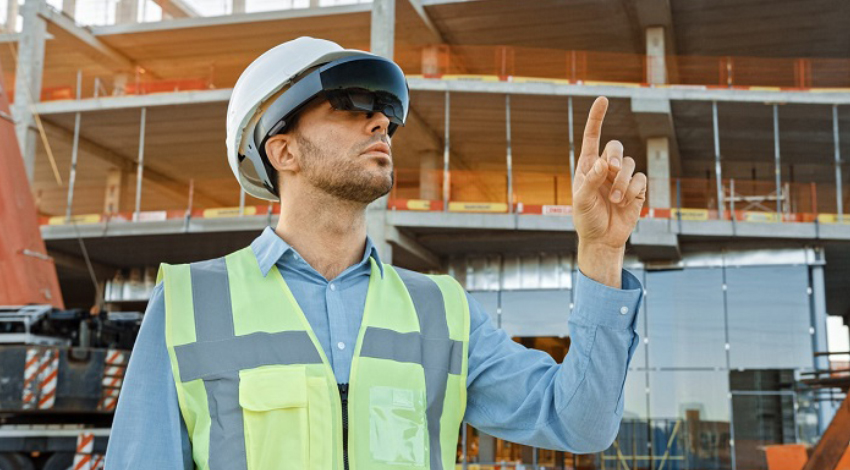The Future of Design and Construction Visualization
Augmented Reality and Virtual Reality in Construction: The Future of Design and Construction Visualization – The architectural, engineering, and construction industries are reaching a pivotal moment regarding adopting virtual and augmented reality technologies, and it’s essential to take notice.
There is a significant opportunity for construction and design professionals to leverage VR/AR technologies. The emergence of these technologies is producing a new generation of architects and designers, signaling a clear shift.
As Tony Parisi, the global head of AR, VR, and innovation at Unity Technologies, a popular game engine, stated in an interview with The New York Times, “real-time 3D will likely be extensively used in the building industry. Just imagine the potential savings on renovation costs alone”.
AR and VR Explained in Detail
To provide users with a fully immersive digital experience, wearable technology, such as smart glasses, is commonly used in both augmented reality (AR) and virtual reality (VR). However, their approaches to integrating the real world with the digital environment are distinct.
With AR, users are immersed in a hybrid reality where digital elements are overlaid onto their physical surroundings. Sometimes, this experience is described as “mixed reality.”
Conversely, in VR, the user is entirely immersed in a digital environment and is disconnected from the real world. These technologies, taken together, are known as extended reality (XR).
How teams generate interactive, lifelike digital representations using BIM and XR?
The original design produced by the project team and collaboratively edited in their BIM software is duplicated in the virtual and augmented reality settings that enable these simulations. Project teams typically adhere to a four-step iterative process to integrate BIM data with their extended reality platforms:
- Construction: The engineering team collaboratively creates the building model using BIM software. Real-life data is transformed into a digital model using techniques such as reality capture, giving project teams a precise foundation on which to build their design.
- Clone: They copy the original design onto a VR or AR platform. The model built in BIM software and the digital twin, which is available only for viewing in a virtual environment, are now two distinct models.
- Explore: During a VR session, team members use a headset and handheld controllers to navigate the virtual environment. With the use of AR technology, digital features from the building model appear superimposed over their real surroundings. Team members can uncover latent design flaws by exploring and analyzing these settings.
- Improve: To address these issues, the team returns to the BIM model and repeats the first step of the procedure.
How are augmented and virtual reality utilized in architecture?
1. Creating prototypes
Architects can accelerate the process of transforming CAD models into photorealistic representations and augmented reality environments using VR and AR.
This is particularly advantageous as it allows for faster translation of 3D building models from the screen to reality. By providing immediate access to virtual models for all project members, turnaround times are accelerated, and the design process is streamlined.
2. Real-time Project Visualization
Using augmented reality, we can show prospective buyers a precise representation of their project in a real-world setting, providing an accurate preview of what will be constructed in the future.
Even on our website, models can be examined from various angles. To view a full-scale model without foundation, all you need is a smartphone, iPad, or pair of mixed-reality glasses.
3. Sustainable Design
Virtual and augmented reality have found a common application in design – promoting sustainability. With environmental consciousness on the rise among architects, they must now consider the impacts of climate change in their plans.
Through virtual reality (VR), sustainable designs are brought to life with environmental analysis and streamlined procedures at every carbon emission level.
This provides a unique opportunity to visualize the color-coded façade of a house like a heat map and consider a home’s energy efficiency and thermal insulation for future generations.
4. Online Tours
If you can’t physically visit the construction site, augmented and virtual reality provides virtual tours as an alternative option. Architects can create a guided tour that allows clients to navigate easily and precisely.
This is great for real estate companies looking to showcase a design and make changes based on client feedback. To help sell the property, 3D models or immersive experiences can be utilized. Additionally, it’s perfect for museums, tourist attractions, performances, and more.
These are just a few examples, but this immersive technology has countless other uses which offer numerous benefits.
Bottom Line
It’s fascinating to contemplate how the industry will evolve in the coming years because VR, AR, and MR technologies are transforming it in ways that were unimaginable a decade ago.
The architectural and construction industries have a huge opportunity ahead of them in terms of how they design and build in the physical world. Investing in these technologies is the best way to differentiate a business and gain a competitive edge in the industry.
___________________________________________________________
This Article is contributed by Mr. Ed Williams, Director of ProjectPro Inc. He holds massive industry experience and is a Microsoft Dynamics expert who is focused on successful implementations. He is a visionary leader and always aims to deliver the best to the construction and project-oriented industries.
Source: worldconstructiontoday.com




